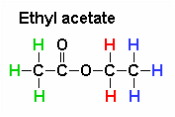
Ethyl acetate contributes to the notorious “nail polish remover” scent in wine and human body odor. It is also responsible for apple-like, banana-like, raspberry-like and strawberry aromas. Ethyl acetate is also found in cereal crops, radishes, fruit juices, beer,and other spirits.
Short-term exposure to high levels of ethyl acetate results first in irritation of the eyes, nose and throat, followed by headache, nausea, vomiting, sleepiness, and unconsciousness. High concentrations can cause CNS depression and congestion of the liver and kidneys. Very high levels may cause a stupor but it is relatively non-toxic. Chronic poisoning has been described as producing anemia, leucocytosis (transient increase in the white blood cell count), and, clouding of the eye, damage to the lungs and heart and kidney and liver problems, cloudy swelling, and fatty degeneration. Athletes exposed to relatively lower levels of Ethyl acetate in facilities where they exercise experience wheezing coughing, rhinitis, or shortness of breath.
Ethyl acetate has been shown to exhibit anti-arthritic, anti-mycotic, anti-nociceptive, hepatoprotective and anti-inflammatory functions (PMID 12673020 , 12781815 , 21340514 , 17507320 ,20363280). Ethyl acetate belongs to the family of Carboxylic Acid Esters. These are carboxylic acid derivatives in which the carbo atom from the carbonyl group is atached to an alkyl or oaryl moiety through an oxygen atom (forming an ester group).
Ethyl acetate can be found in human biofluids such as feces, saliva and urine. It is present in small amounts in healthy children and adults. Abnormal concentrations can be found in Nonalcoholic fatty liver disease (NAFLD), Celiac disease and breast cancer.
CAS No.: 141-78-6; HMDB 31217
